Cravings of Home: Noodles and Noodles
What Food Do You Miss When You Travel? Thoughts of Bagels, Recipes for Lemon Carbonara and Spicy Chinese Ginger Scallion Chili Noodles
Here’s Issue #44. After barely leaving the house for two years, two and a half weeks away felt like a lifetime. It was great to be on the road again, meeting new people, experiencing new places, tasting new flavors. But it was also really great to come home. I tried to bring you along by sharing recipes for borani kadoo and pita. Paid subscribers will receive a comprehensive eating guide to Tel Aviv in the coming weeks, much like the Paris Notebook I published in January. If you have any plans to be in Israel this year, you won’t want to miss it. But first you’ll have to subscribe. Thanks, as always, for your continued support. —Mitchell
What’s the first thing you want to eat when you get home from a trip, the thing that tells your mind, your body, and your palate you’ve returned?
I almost always crave an everything bagel with scallion cream cheese, the unique combination of flavors and textures of which I believe you can’t find anywhere outside the New York metropolitan area. Even these days, after the bagel awakening that’s taken place across the U.S. and around the world, when Everything Bagel spice is so popular Trader Joe’s sells it in large-format shakers and Jeni’s has an Everything Bagel ice cream, nowhere else does the combination of seeds and salt, creaminess and chew, plus oniony goodness come together in the same way as it does in NYC.
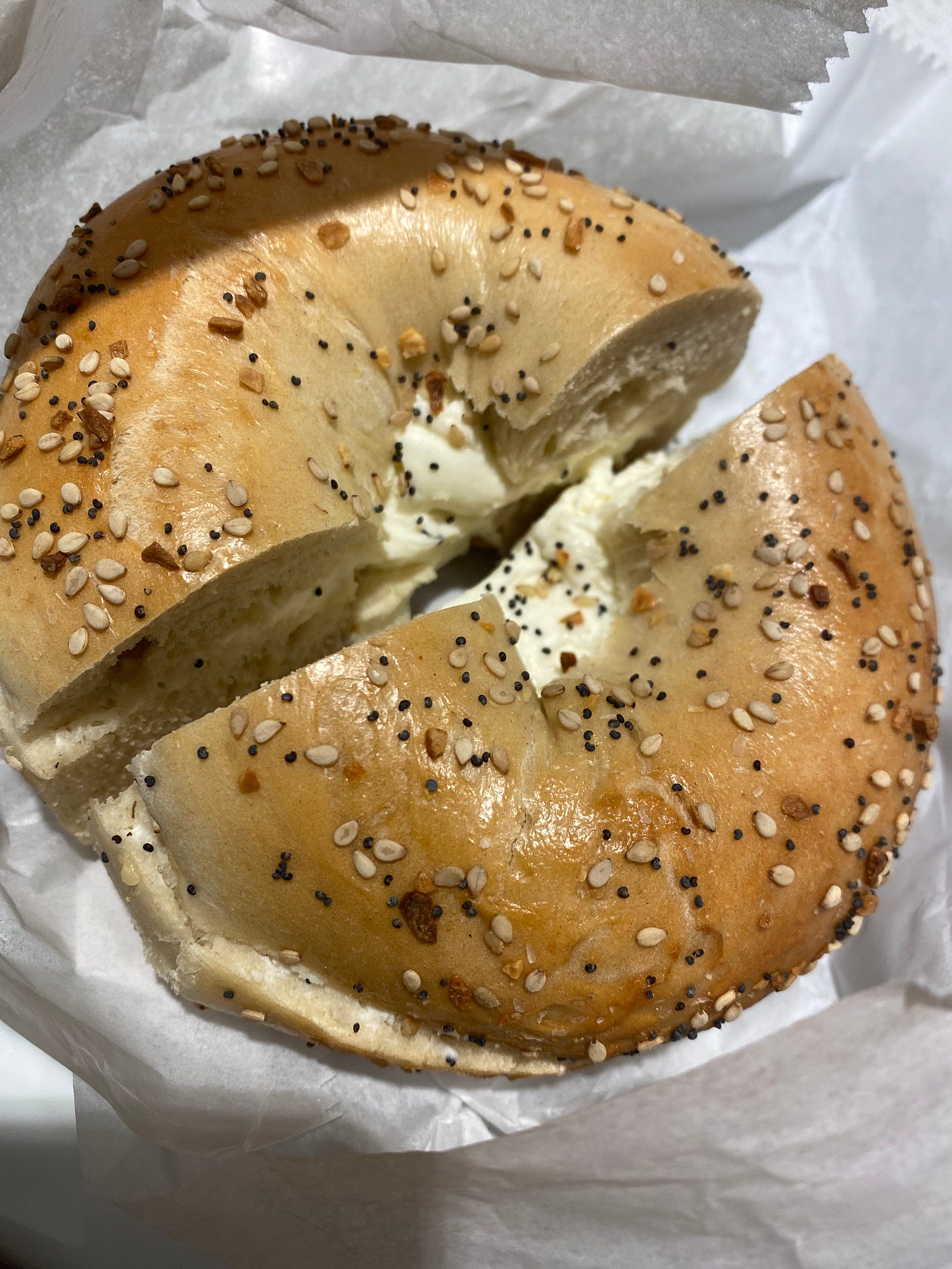
So much has been written and debated about bagels, I don’t want to go there, except to say that so many non–New York bagels lack the requisite crunch of the outer crust that shouldn’t require toasting to find it #imho. Also, sometimes we forget that the texture and flavor of the cream cheese should not be taken for granted. In most towns without their own bagel culture, bagel shops just seem to stir scallions into plain cream cheese, which almost always falls short. I realize that scallions stirred into plain cream cheese is probably all that “scallion cream cheese” is here, too, but the flavor and texture is different in NYC, where perhaps the demand for it requires industrial-sized machines to mash the two together in a way that creates some synergy.
But what’s the first thing I cook?
I was thinking about this upon my return last night after 2 ½ weeks away—traveling both for work and pleasure in the U.A.E., Tel Aviv, and Palm Springs. I covered a lot of ground, eating my way through a variety of cultures and cuisines. On my last flight, from LAX to JFK, I wondered what the first thing I would cook would be. After two years of preparing almost every meal Nate and I consumed, it was a little disorienting to eat breakfast, lunch and dinner out for such an extended period. (I also gained several pounds, which is a topic for another newsletter.) I missed both the act of cooking and the taste of my own food.
I know that when I’m gone for a while without Nate, there likely won’t be any fresh food in the fridge for me to cook with when I return, so the question of what to cook narrows to what’s in the pantry? As is often the case, this time my mind veered toward noodles. I love noodles, no matter which culture they come from. They are quick and comforting. I have lots of different types of noodles in a box labeled “pasta” in the cupboard and I often have fresh ones in the fridge or freezer.
For years, our go-to pasta on return from a trip was a recipe that was given to us by our Florentine friend Gabriella. The founder of several universities in Florence, including a school of cooking and hospitality called Apicius, Gabriella was often on the road before the pandemic and she has a residence in New York where she and her partner David would spend many months a year. We once asked her what the first thing she ate was when she got back to Florence, expecting a cliché like ribolita. Instead, she shared a simple lemon pasta dish that soon became a favorite of ours over the years. It only uses a few ingredients that you will likely have on hand no matter how long you’ve been away. And as with all the best Italian dishes, it has few ingredients that add up to more than the sum of its parts.
RECIPE: Gabriella’s Bentornato Lemon Pasta
(Serves 3 to 4)
There are two ways to make this dish, with a mini chopper (aka a mini food processor), or without. If you have one, it’s super easy and the action of the chopping blade seems to bring out more of the essential oils in the lemon zest, which improves the flavor of the final dish. (Note, full-size food processors don’t seem towork as they can’t chop the zest finely enough, in my experience.) If you don’t have a chopper, a Microplane grater is essential and makes quick work of the dish.
12 ounces dry spaghetti, linguine, or other long pasta
1 egg yolk
2 ounces Parmigiano-Reggiano or Pecorino, in small chunks
Zest of 2 lemons, peeled in strips with a vegetable peeler, leaving the pith behind
1/2 teaspoon coarsely ground black pepper
Pinch red pepper flakes (I use Calabrian chilies)
Pinch salt
3 tablespoons unsalted butter, melted and cooled
Cook the linguine in a large pot of generously salted, boiling water until al dente. Meanwhile, in a mini chopper, combine the chunks of cheese, strips of lemon zest, black pepper, red pepper flakes, and salt. Pulse to finely grind and transfer to a large bowl. (Alternately, use a Microplane grater to finely grate the cheese and zest the lemons and combine in a large bowl with the black pepper, red pepper, and salt.) Add the egg yolk and melted butter and stir to form a thick paste. Stir in 3 or 4 tablespoons of the boiling pasta water to loosen the mixture. Strain the cooked pasta, do not rinse, and while still hot, dump into the bowl with the other ingredients. Using tongs, toss quickly until the noodles are covered with the sauce and the cheese melts. Serve immediately.
Although I love this dish, upon my return from this trip, I craved a different noodle. The first thing I decided I would make was my new favorite Chinese dish, a kind of spicy scallion ginger noodle based on a recipe I saw on The Foodie Diaries. I seem to be always looking for Chinese noodle recipes. My Evernote recipe notebook is full of clips. But when I first made this one a couple of months ago, it stopped me in my tracks. I loved it immediately.
You make the sauce as though you are making a quick combination chili oil and scallion ginger sauce, by combining the aromatics and pouring smoking hot oil over them. If you make your own chili oil and ginger scallion sauce, you could substitute that for the base of this. Of course, because it is my nature, I’ve tinkered with the original recipe a little. This is not because I thought it needed improvement, mind you, it was a great recipe to begin with. But as you know, I always have things on hand I want to use up #wastenot, and I’m always on the lookout for ways to use leftover bits of Chinese things, dipping sauces, fermented pastes, especially the rendered fat from roasting Chinese pork. These noodles welcomed them all.
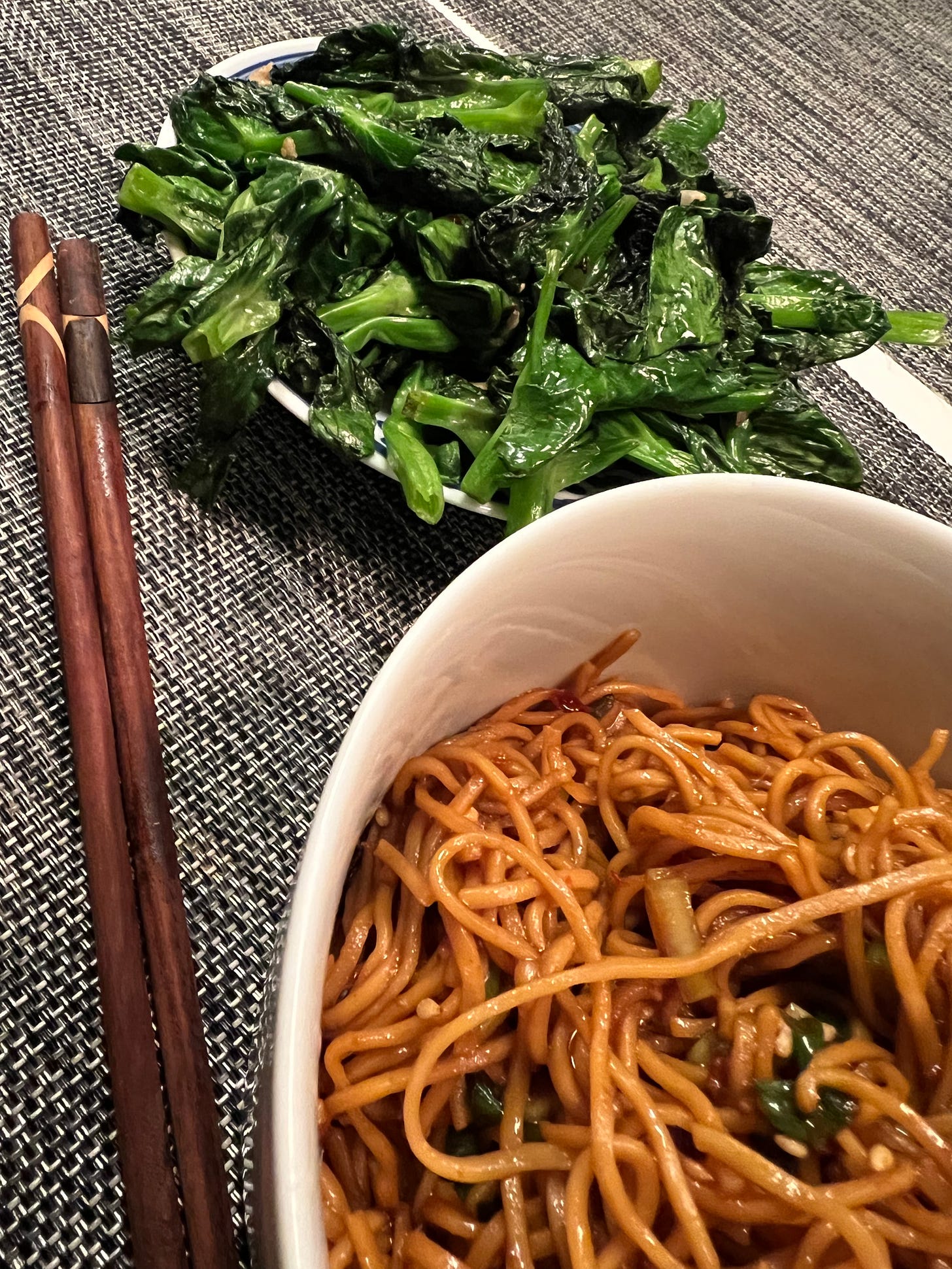
A note about the noodles. You can use (and I have) many different types of long noodles to make this dish, fresh or dried Chinese noodles, fresh or dried Italian pasta. Lately, I have a pack of Hong Kong Style Pan-Friend noodles in my fridge. They are versatile and vacuum-sealed, so they keep for a long time. (If you follow me on Instagram you know I recently went through a Cantonese pan-fried noodle phase, which is when I started stocking these noodles.) If you are using dried Italian pasta, you’ll want to cook it past al dente to get the right texture.
Reflecting a little on my decision about what to cook first when I got back, I think the reason I chose these noodles was that during my travels I ate many different cuisines—Lebanese and other Middle Eastern, Indian, Japanese, and Italian—but I was missing that distinct ginger, garlic, scallion, soy combination of Chinese food. I made a batch of these noodles for lunch my first day home. I ate three bowls and contemplated a fourth. It’s good to travel. And it’s good to be home.
RECIPE: Ginger Scallion Chili Noodles
(Makes enough for 4 to 8, depending on what else you are serving, though I would be lying if I didn’t say the first time I made them I almost ate the entire thing myself.)
These noodles are are based on a recipe developed by and published on The Foodie Diaries. They are great. I only changed a few things based on my personal tastes, what I have lying around, and a few techniques I found helpful.
1 pound fresh, long noodles of choice, such as Hong Kong style pan-fried or lo mein noodles, or 12 ounces dried noodles
1 to 2 tablespoons finely grated ginger (use a Japanese grater or Microplane), or minced to a paste
1 bunch (about 5) scallions, white and green parts, thinly sliced (about 1 cup), more is good, too
3 medium cloves garlic, finely grated (use a Microplane), or minced to a paste
1 tablespoon crushed red chili flakes (I use Sichuan xiang la la jiao mian ground chili) or gochugaru (Korean red pepper flakes)
1 tablespoon toasted sesame seeds
Salt
¼ cup peanut or other neutral oil
1 tablespoon rendered pork fat, from roast Chinese pork, porchetta, or even bacon (optional)
1½ tablespoons light soy sauce
1½ tablespoons dark soy sauce
1 ½ teaspoons rice vinegar
1/4 teaspoon Sichuan peppercorn oil
1 teaspoon chili oil with sediment or your favorite fermented hot pepper sauce
¼ teaspoon sesame oil
1 teaspoon white, brown or palm sugar
1 heaping tablespoon red or white miso
1 tablespoon doubanjiang, Sichuan fermented broad bean sauce (I like Lee Kum Kee’s toban djan chili bean sauce), or additional miso
Bring a large pot of unsalted water to a boil to cook the noodles. If using fresh noodles, you will only cook them for a minute or two once they are added to the water and come back up to a boil. If using dried noodles, especially Italian ones, you will want to cook them past al dente, until they are uniformly soft bit not mushy.
Meanwhile, in a large heat-proof bowl (the larger the bowl, the easier and less messy the noodles will be to toss with the sauce at the end), combine the ginger, scallions, garlic, chili flakes, and sesame seeds. Add a generous pinch of salt and mix.
In a small frying pan, heat the oil with the pork fat, if using, over medium high heat. You want to heat the oil until it starts to smoke (see video). When it does, carefully lift the pan and pour the oil into the bowl over the other ingredients. It will sizzle and splatter. Mix well. When the sizzling stops, add the light and dark soy sauces, vinegar, Sichuan peppercorn oil, chili oil, sesame oil and sugar, and mix well.
Place the miso and doubandjiang in a small bowl. Add 1/2 cup of the boiling noodle cooking water to the bowl and stir to dissolve the pastes. Add this to the large bowl with the other ingredients and stir to combine.
As soon as the noodles have reached the right doneness, drain them in a large colander and dump them hot into the prepared sauce. Use tongs to toss until all of the noodles are even coated and the scallions and other ingredients are well distributed. Serve in small bowls. Note these noodles keep well for up to a week or so and they are delicious cold, room temperature, or reheated.



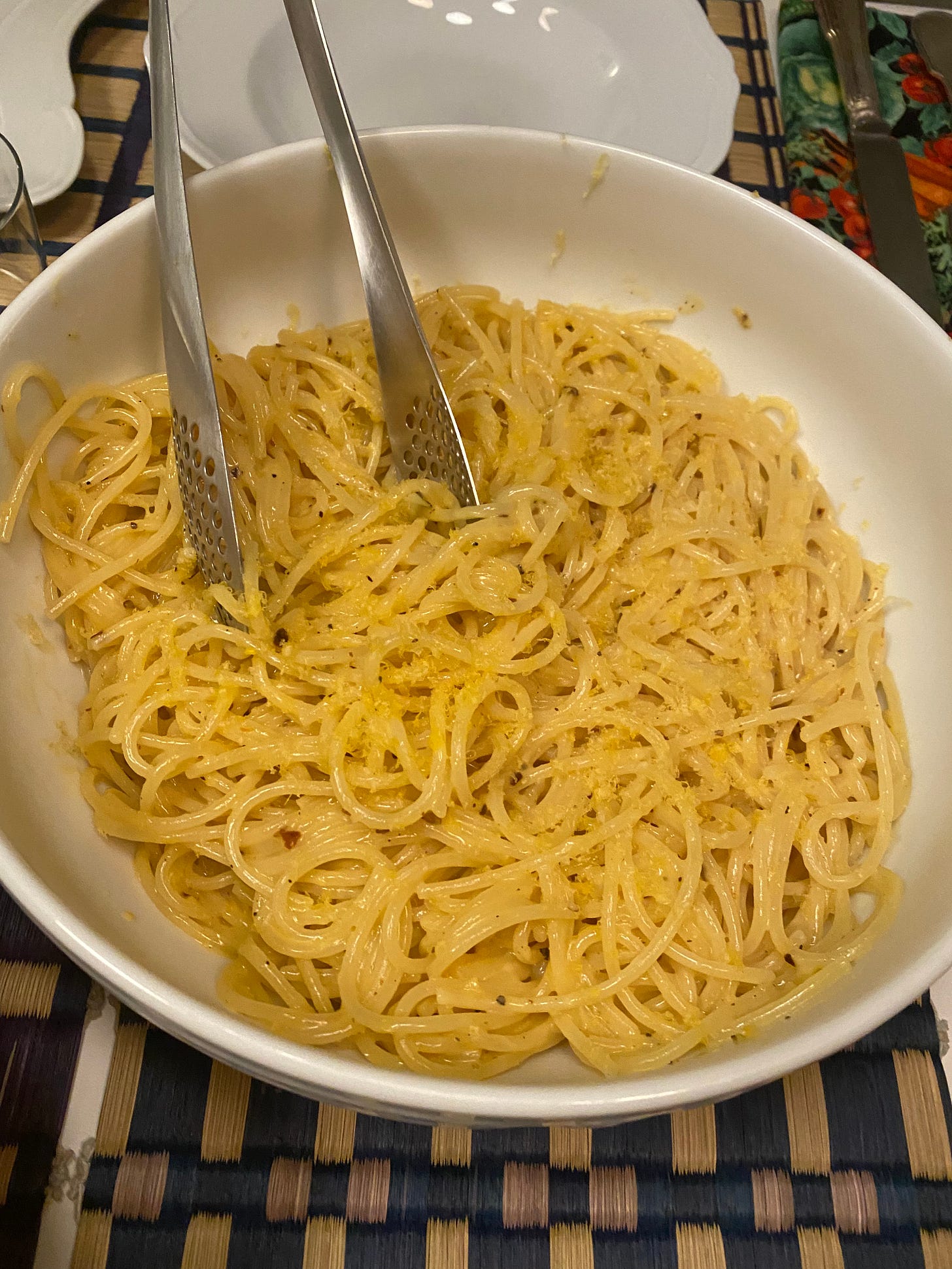
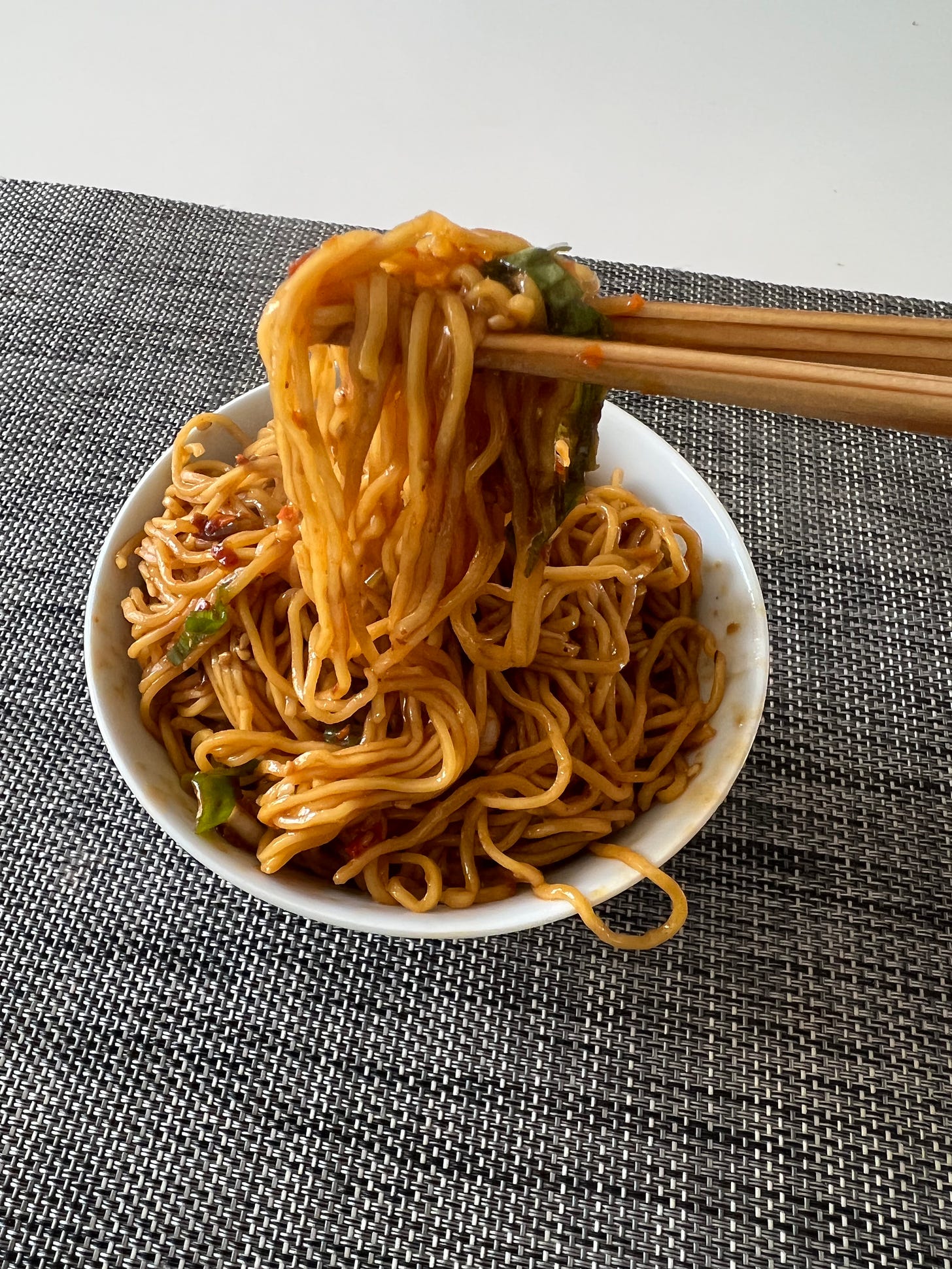
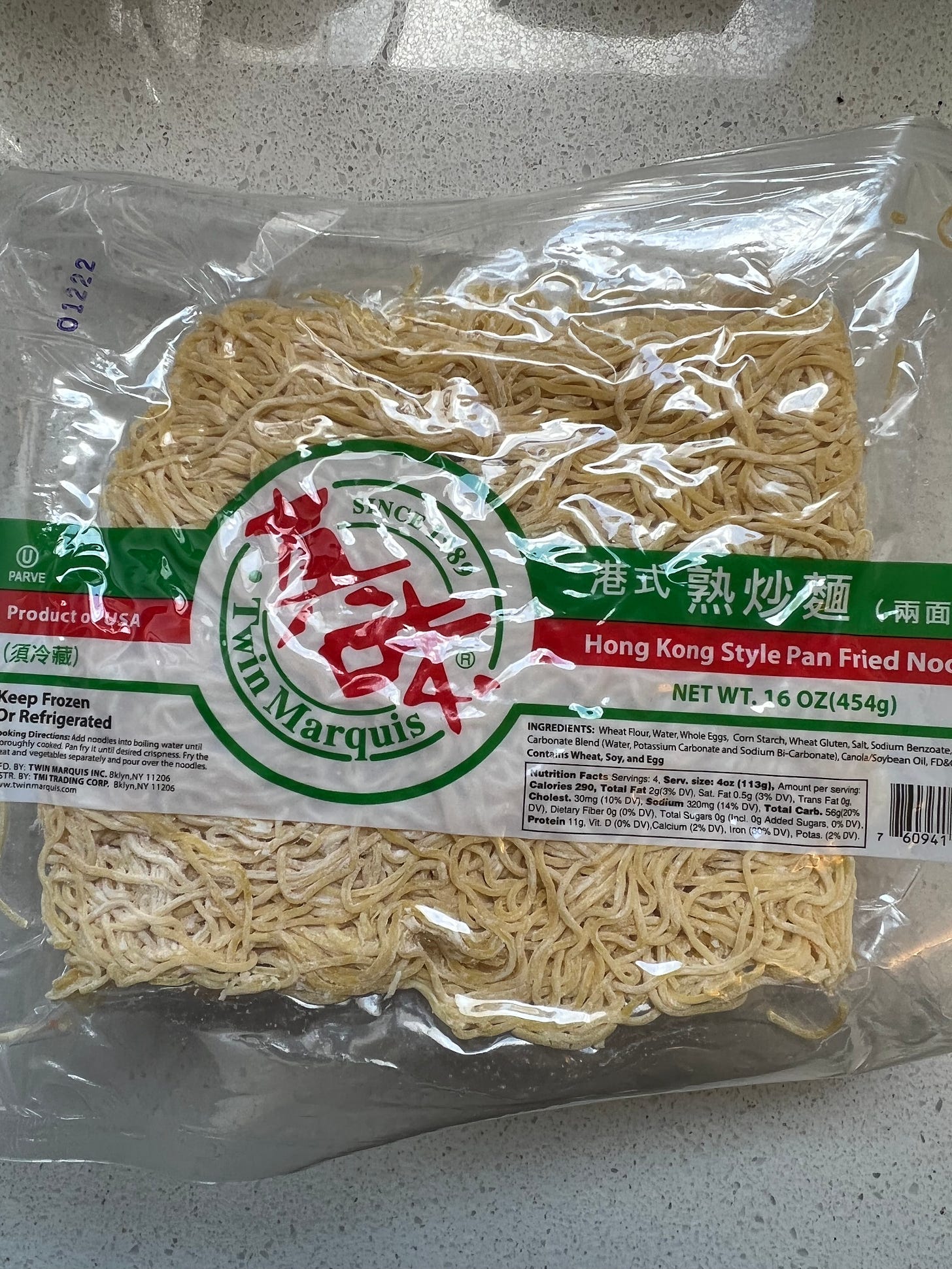

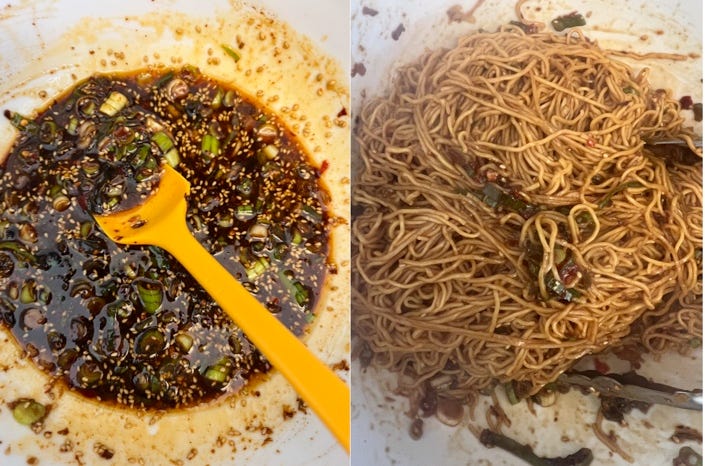
Welcome home! Yours was my first substack subscription, activated on a whim, not quite knowing what to expect. Worth far more than whatever I paid. Your writing style is so refreshing. What a joy to savor your writing and culinary creations, sans the fluff and frivolity of most bloggers. Thank you.